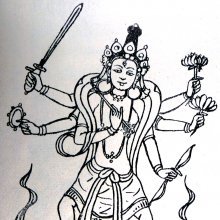Vajrananga, Vajrānaṅga: 2 definitions
Introduction:
Vajrananga means something in Buddhism, Pali, Hinduism, Sanskrit. If you want to know the exact meaning, history, etymology or English translation of this term then check out the descriptions on this page. Add your comment or reference to a book if you want to contribute to this summary article.
Images (photo gallery)
In Buddhism
Tibetan Buddhism (Vajrayana or tantric Buddhism)
Source: archive.org: The Indian Buddhist IconographyVajrānaṅga (वज्रानङ्ग) refers to one of the various forms of Mañjuśrī having their Sādhana described in the 5th-century Sādhanamālā (a collection of sādhana texts that contain detailed instructions for rituals).—His Colour is yellow; his Āsana is the pratyālīḍha; he has six or four hands.—Vajrānaṅga as the name implies, is the Buddhist God of Love, the prototype of the Hindu God Madana in the Buddhist Pantheon. The flowery bow and the arrow of flowers are strikingly common to both. Unlike the Hindu Anaṅga, however, several other weapons besides these are also attributed to the Buddhist God of Love.
The Dhyāna (meditation instructions) of Vajrānaṅga is described in the Sādhanamālā as follows:
“The worshipper should think himself as Ārya-Mañjughoṣa in the form of Vajrānaṅga with yellow complexion, and six arms. With the two principal hands he draws to the ear the bow of flowers charged with an arrow of a red lotus bud; the two remaining right hands carry the sword and the mirror, while the two left hold the lotus and the Aśoka bough with red flowers. He bears the image of Akṣobhya on his Jaṭāmukuṭa, stands in the Pratyālīḍha attitude, appears a youth of sixteen years and displays the intense Śṛṅgāra-rasa”.
It is said in the Sādhanamālā that in the act of bewitching a woman, the worshipper should imagine himself as piercing her bosom with the arrow of the lotus bud. The woman falls flat on the ground in a swoon, whereupon the worshipper should visualise her legs as being tied by the chain which is the bow. Then he should imagine that the noose of the lotus stalk is flung round her neck, and she is drawn to his side. Thereupon, he should think that he is striking her with the Aśoka bough, is frightening her with the sword, and subsequently he has only to confront her with the mirror by which she is completely subjugated.

Tibetan Buddhism includes schools such as Nyingma, Kadampa, Kagyu and Gelug. Their primary canon of literature is divided in two broad categories: The Kangyur, which consists of Buddha’s words, and the Tengyur, which includes commentaries from various sources. Esotericism and tantra techniques (vajrayāna) are collected indepently.
Languages of India and abroad
Sanskrit dictionary
Source: Cologne Digital Sanskrit Dictionaries: Edgerton Buddhist Hybrid Sanskrit DictionaryVajrānaṅga (वज्रानङ्ग).—a name of Mañjuśrī: Sādhanamālā 124.3 etc.
Sanskrit, also spelled संस्कृतम् (saṃskṛtam), is an ancient language of India commonly seen as the grandmother of the Indo-European language family (even English!). Closely allied with Prakrit and Pali, Sanskrit is more exhaustive in both grammar and terms and has the most extensive collection of literature in the world, greatly surpassing its sister-languages Greek and Latin.
See also (Relevant definitions)
Relevant text
Search found 1 books and stories containing Vajrananga, Vajrānaṅga; (plurals include: Vajranangas, Vajrānaṅgas). You can also click to the full overview containing English textual excerpts. Below are direct links for the most relevant articles:
The Indian Buddhist Iconography (by Benoytosh Bhattachacharyya)
